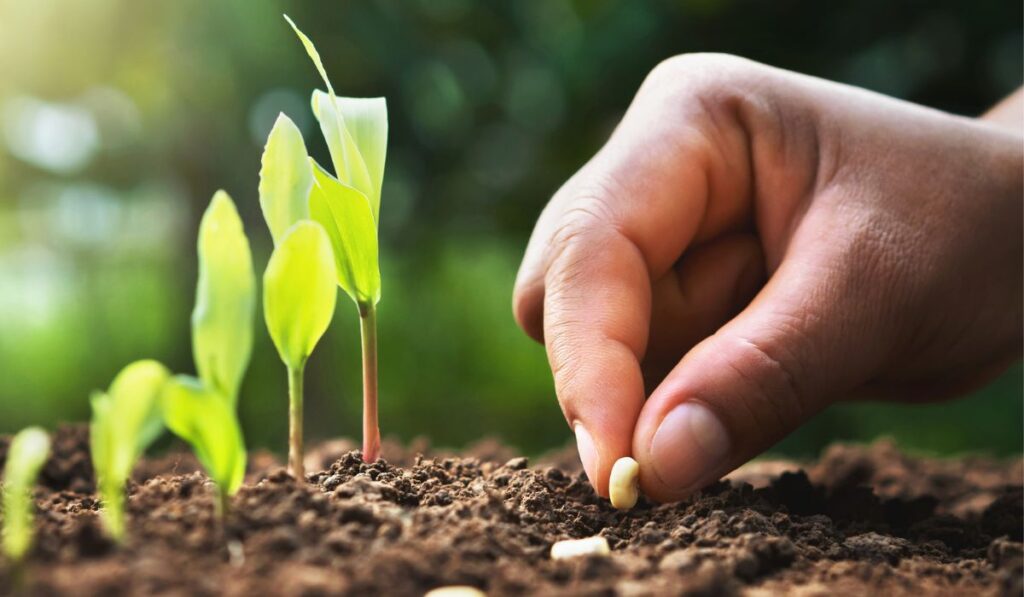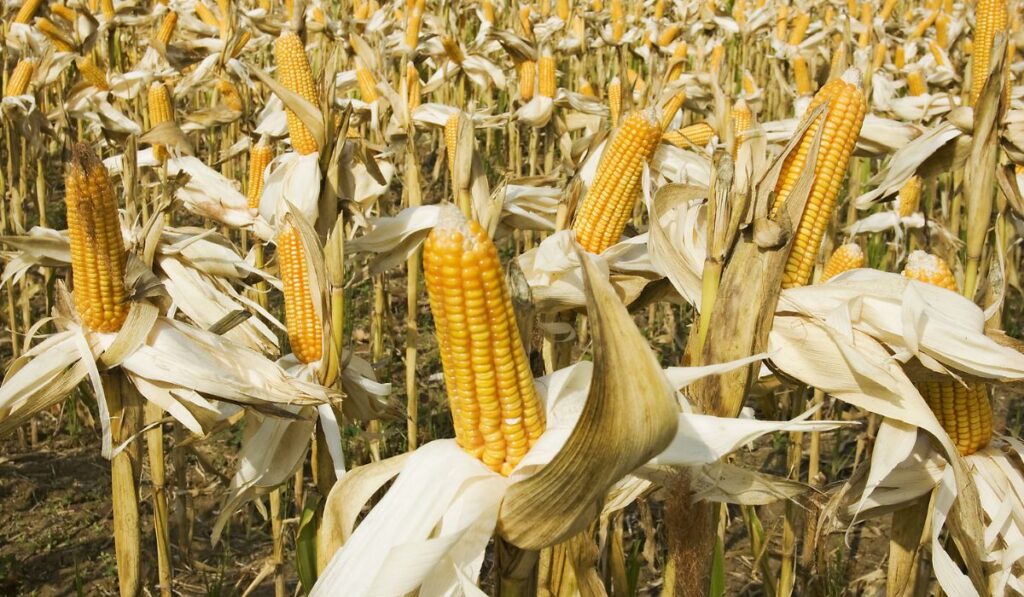Corn! It may not sound as sexy as tomatoes or zucchini, but this all-American staple is a beloved summer crop in many home gardens. It’s sweet, it’s versatile, and kids love it (even if they won’t eat it). So how do you grow this incredible crop? Let’s start with the basics – when is the best time to plant corn?
The best time to plant corn is in April or May, well after the last frost has passed. The rule of thumb is to wait until the soil temperature reaches 60 F. Corn takes three months to mature, and the whole season — from planting to harvest — should fall within the warmest months of the year.
Few things are as satisfying as shucking your own corn, slathering on some butter, and taking a big bite. But if you want your corn sweet, tender, and safe from frost damage, you need to be patient. With a little bit of planning, you can be sure to have the best corn on the block — just in time for summer BBQs! So let’s look at more detail about planting and caring for your corn crop.
Best Time of Year for Planting Corn

Corn is a warm weather crop, so it’s best to plant it three to four weeks after the danger of frost has passed. In most cases, that means late April or early May. But if you live in a climate with a long growing season, you can plant corn as early as March.
Sow the corn when the ground has completely thawed and the soil temperatures have reached at least 60 F (16 C). If you plant the corn too early, the seeds are most likely to just rot in the ground. Even if they do germinate, the plant yield will be significantly reduced.
If you don’t get at least three months of warm weather (60-90 F), your corn won’t have enough time to mature fully. In that case, you can also plant corn indoors in peat pots about three weeks before your last expected frost date. Then transplant the seedlings outdoors after the danger of frost has passed.
Assessing the Weather in Your Area
Because corn is highly susceptible to frost damage, it’s important to keep an eye on the forecast in the weeks leading up to planting. Plenty of online resources that can help you do that.
The Old Farmer’s Almanac and the National Gardening Association have guides on frost dates. However, the data is based on historical averages, so it’s not always accurate.
The best way to ensure favorable conditions is to use a soil thermometer. You can find one at your local gardening store or order one online (on Amazon). Stick the thermometer into the ground at a depth of 3 to 4 inches (or 7 to 10 cm), and check the temperature daily for a week. Once the soil temperature has reached 60 F (16 C), you’re good to go.
What Soil Conditions Does Corn Grow Best In?
Corn is a notoriously greedy crop, especially when it comes to nitrogen. That means it’s important to choose a site with rich, loamy soil and a lot of organic matter. You can also improve the quality of soil by adding compost or aged manure.
Rake it into the top few inches of the soil a few weeks before you plant. If you’re short on time, you can also use a high-nitrogen fertilizer (on Amazon) later in the season. Make sure you follow the instructions closely.
Corn also grows well in rotation with nitrogen-fixing crops like legumes, soybeans, or alfalfa. These plants naturally replenish the nitrogen in the soil, making it richer for future crops.
Another important factor is drainage. Corn doesn’t like “wet feet,” and that’s why they’re grown on raised rows or mounds. If your soil is clay-based, it’s a good idea to amend it with sand or vermiculite (on Amazon) to improve drainage.
Other soil amendments that can be beneficial for corn include:
- Limestone (on Amazon), which raises the pH
- Phosphate rock (on Amazon), which increases phosphorus levels
- Green sand (also on Amazon), which provides potassium
How Long Does it Take for Corn to Grow?
Corn is a fast-growing crop, and it gets ready to harvest about 70 to 100 days after planting. The exact time depends on the variety of corn you’re growing and the weather conditions during the growing season.
To get an accurate estimate, check the seed packet for the “days to maturity” rating. That’s the number of days from planting to harvest under ideal conditions. Then add 10 to 14 days to account for less than ideal conditions.
Here’s a quick overview of the stages of corn growth:
- Seed germination: five to 10 days
- Vegetative growth: about a month
- Tasseling and silking: two to three weeks
- Ripening: three to four weeks
Corn is an annual crop. After the harvest, the plants will die and need to be replaced with fresh seedlings the following year.
When Should You Harvest Corn?

Corn is picked when it’s “milky” ripe. This is the stage when the kernels are at the peak of their sweetness and have just the right amount of moisture. If you don’t pluck the corn at this stage, it will become starchy and tough. Alternatively, if you harvest too early, the kernels may not have fully developed yet.
That said, the milky stage lasts for only a day or two, so timing is the key. Here’s a few key indicators that your corn is ready for picking.
- The tassels or silk at the top of the ear turn brown and dry.
- The ear also becomes rounded at the top, and the leaves usually turn dark green. To be sure, peel the husk back on a few ears and look at the kernels. They should be soft and plump.
- Pierce the kernels with your fingernail. If you see a milky white liquid oozing out, it’s ready to be picked. In plants with multiple ears, the upper ear matures two to three days before the lower ones.
The corn harvest window opens about 15 days after the silks appear, but weather plays a huge role in the ripening process. A few hot days can speed things up, while a prolonged period of cool weather can delay it. So, it’s best to keep a close eye on the corn in the weeks leading up to harvest.
How Should You Store Corn?
Corn starts losing its sweetness as soon as it’s picked. Some sweet corn varieties can quickly lose their sugars and become starchy within 24 hours of harvest. The best-flavored corn is always enjoyed fresh from the field. Of course, you can’t eat all the corn you grow at once (or can you?).
If your goal is to save the corn for a few more days, simply wrap the unopened ears in a damp paper towel and store them in the refrigerator. This will keep the corn fresh for up to five days.
But for long-term storage, you’ll need to blanch and freeze the corn.
How to Blanch Corn
Blanching is a process of briefly cooking the corn in boiling water to stop the enzymes from breaking down the sugars. Blanched corn can be stored in the freezer for up to eight months.
Here’s how to do it:
- Ideally, the corn should be picked in the morning when the kernels are the sweetest and most plump.
- Fill a deep pot with water and bring it to a boil.
- While the water is heating up, shuck the corn and remove all the silk.
- Slice the cob or leave it whole. It’s up to you.
- When the water boils, add the corn. Make sure the ears are fully immersed in the water.
- Let them cook for seven to 10 minutes, depending on the size. The bigger the ear, the longer it needs to blanch.
- Meanwhile, have a big bowl of ice water ready. When the corn is done blanching, immediately transfer it to the ice water. This is done to prevent overcooking.
- Let the corn cool in the ice water for the same amount of time it was blanched.
- Drain the water and dry the ears with a clean towel.
- Now you’re ready to freeze the corn. Place the whole ears in freezer bags or cut the kernels off the cob and freeze them in smaller bags.
- Label the bags with the date and variety of corn. You’re done!
How to Prevent Frost Damage In Corn
Frost damage is one of the most common problems corn crops face. The plants are sensitive to freezing temperatures, and even a light frost can damage immature plants. This leaves you with buggy, deformed leaves and smaller kernels.
However, young budding saplings are more resistant than older plants. They survive unless the ground freezes 2 to 3 inches deep.
The best way to prevent frost damage is not to plant the corn until the soil has warmed up. The U.S Department of Agriculture (USDA) recommends specific planting dates for different areas of the country. Even crop insurance is only applicable if you follow these dates.
If you’re growing corn in the north, where the risk of frost is higher, consider using row covers (on Amazon). They are made of a lightweight woven fabric that helps to insulate the plants from the cold.
Some new frost-resistant varieties are also entering the market. Check with your local authorities or seed supplier to see if they’re suitable for your area.
